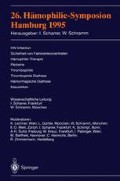Zusammenfassung
Venöse Thrombembolien mit einer jährlichen Inzidenz von 1/1000 sind ein ernstes medizinisches Problem. Neben einer Vielzahl von Ursachen, z. B. Protein-C-Mangel, Protein-S-Mangel, konnte als ein weiterer Faktor die APC-Resistenz festgestellt werden [2]. Die APC-Resistenz kommt in der Bevölkerung bei ungefähr 5% vor [10]. In Fällen mit familiären Thrombosen wurde als Ursache die APC-Resistenz bei 50 % ermittelt [3].
Access this chapter
Tax calculation will be finalised at checkout
Purchases are for personal use only
Preview
Unable to display preview. Download preview PDF.
Literatur
Bertina RM, Koeleman BPC, Koster T, Rosendaal FR, Dirven RJ, Ronde H de, Van derVelden PA vander, Reitsma PH (1994) Mutation in blood coagulation factor V associated with resistance to activated protein. Nature 369:64–67
Dahlbäck B (1995) Inherited thrombophilia: resistance to activated protein C as a pathogenic factor of venous thromboembolism. Blood 85:607–614
Dahlbäck B (1995) The protein C anticoagulant system: inherited defects as basis for venous thrombosis. Thrombos Res 77:1–43
Kalafatis M, Rand MD, Mann KG (1994) The mechanism of inactivation of human factor V and human factor Va by activated protein C.J Biol Chem 269:31869–1880
Pringlinger U, Binder PR Physiologie und Pathophysiologie des fibrinolytischen Systems. 145-154
deRonde H, Bertina RM (1994) Laboraty diagnosis of APC-resistance: a critical evaluation of the test and the development of diagnostic criteria. Thromb Haemost 72:880–886
Shizuka R, Kanda T, Amagai H, Kobayashi I (1995) False-positive activated protein C (APC) sensitivity ratio caused by freezing and by contamination of plasma with Platelets. Throm Res 78:189–190
Varadi K, Moritz B, Lang H, Bauer K, Preston E, Peake I, Rivard GE, Keil B, Schwarz HP (1995) A romogenic assay for activated protein C resistance. Br J Haemotol 90:884–891
Wiesinger K, Hohenwallner W (1994) Bestimmung der APC-Resistenz nach enzymatischem Abbau von Heparin durch DadeR Hepzym™. Berichte ÖGKC 17:135–137
Zöller B, Dahlbäck B (1994) Linkage between inherited resistance to activated protein C and factor V mutation in venous thrombosis. Lancet 343:1536–1538
Rights and permissions
Copyright information
© 1997 Springer-Verlag Berlin Heidelberg
About this paper
Cite this paper
Siegert, G., Trautmann, S. (1997). Freisetzung von Plättchen-PAI als mögliche Ursache für eine abnorme APC-Ratio. In: 26. Hämophilie-Symposion 1995. Springer, Berlin, Heidelberg. https://doi.org/10.1007/978-3-642-60418-8_27
Download citation
DOI: https://doi.org/10.1007/978-3-642-60418-8_27
Publisher Name: Springer, Berlin, Heidelberg
Print ISBN: 978-3-540-61101-1
Online ISBN: 978-3-642-60418-8
eBook Packages: Springer Book Archive

